Activation of the ERK1/2 signaling pathway during the osteogenic differentiation of mesenchymal stem cells cultured on substrates modified with various chemical groups
- PMID: 24069599
- PMCID: PMC3771309
- DOI: 10.1155/2013/361906
Activation of the ERK1/2 signaling pathway during the osteogenic differentiation of mesenchymal stem cells cultured on substrates modified with various chemical groups
Abstract
The current study examined the influence of culture substrates modified with the functional groups -OH, -COOH, -NH2, and -CH3 using SAMs technology, in conjunction with TAAB control, on the osteogenic differentiation of rabbit BMSCs. The CCK-8 assay revealed that BMSCs exhibited substrate-dependent cell viability. The cells plated on -NH2- and -OH-modified substrates were well spread and homogeneous, but those on the -COOH- and -CH3-modified substrates showed more rounded phenotype. The mRNA expression of BMSCs revealed that -NH2-modified substrate promoted the mRNA expression and osteogenic differentiation of the BMSCs. The contribution of ERK1/2 signaling pathway to the osteogenic differentiation of BMSCs cultured on the -NH2-modified substrate was investigated in vitro. The -NH2-modified substrate promoted the expression of integrins; the activation of FAK and ERK1/2. Inhibition of ERK1/2 activation by PD98059, a specific inhibitor of the ERK signaling pathway, blocked ERK1/2 activation in a dose-dependent manner, as revealed for expression of Cbf α -1 and ALP. Blockade of ERK1/2 phosphorylation in BMSCs by PD98059 suppressed osteogenic differentiation on chemical surfaces. These findings indicate a potential role for ERK in the osteogenic differentiation of BMSCs on surfaces modified by specific chemical functional groups, indicating that the microenvironment affects the differentiation of BMSCs. This observation has important implications for bone tissue engineering.
Figures
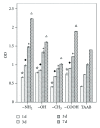


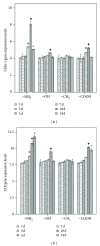

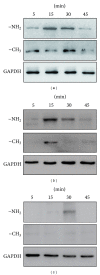
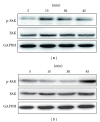
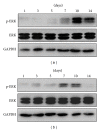
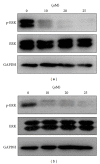

Similar articles
-
Tanshinone IIA Reverses Osteogenic Differentiation of Bone Marrow Mesenchymal Stromal Cells Impaired by Glucocorticoids via the ERK1/2-CREB Signaling Pathway.Chem Biol Drug Des. 2025 Mar;105(3):e70069. doi: 10.1111/cbdd.70069. Chem Biol Drug Des. 2025. PMID: 40047141
-
Osteogenic response of mesenchymal stem cells to continuous mechanical strain is dependent on ERK1/2-Runx2 signaling.Int J Mol Med. 2012 Jun;29(6):1083-9. doi: 10.3892/ijmm.2012.934. Epub 2012 Mar 8. Int J Mol Med. 2012. PMID: 22407386
-
Synthetic osteogenic growth peptide promotes differentiation of human bone marrow mesenchymal stem cells to osteoblasts via RhoA/ROCK pathway.Mol Cell Biochem. 2011 Dec;358(1-2):221-7. doi: 10.1007/s11010-011-0938-7. Epub 2011 Jul 8. Mol Cell Biochem. 2011. PMID: 21739156
-
Aloin promotes osteogenesis of bone-marrow-derived mesenchymal stem cells via the ERK1/2-dependent Runx2 signaling pathway.J Nat Med. 2019 Jan;73(1):104-113. doi: 10.1007/s11418-018-1249-z. Epub 2018 Sep 14. J Nat Med. 2019. PMID: 30218208
-
Biomaterials regulates BMSCs differentiation via mechanical microenvironment.Biomater Adv. 2024 Feb;157:213738. doi: 10.1016/j.bioadv.2023.213738. Epub 2023 Dec 22. Biomater Adv. 2024. PMID: 38154401 Review.
Cited by
-
Facile construction of mechanically robust and highly osteogenic materials for bone regeneration.Mater Today Bio. 2025 May 3;32:101809. doi: 10.1016/j.mtbio.2025.101809. eCollection 2025 Jun. Mater Today Bio. 2025. PMID: 40568011 Free PMC article.
-
Bladder Cancer Cells Exert Pleiotropic Effects on Human Adipose-Derived Stem Cells.Life (Basel). 2022 Apr 7;12(4):549. doi: 10.3390/life12040549. Life (Basel). 2022. PMID: 35455040 Free PMC article.
-
Application and progress of 3D printed biomaterials in osteoporosis.Front Bioeng Biotechnol. 2025 Feb 4;13:1541746. doi: 10.3389/fbioe.2025.1541746. eCollection 2025. Front Bioeng Biotechnol. 2025. PMID: 39968010 Free PMC article. Review.
-
Organizational metrics of interchromatin speckle factor domains: integrative classifier for stem cell adhesion & lineage signaling.Integr Biol (Camb). 2015 Apr;7(4):435-46. doi: 10.1039/c4ib00281d. Integr Biol (Camb). 2015. PMID: 25765854 Free PMC article.
-
Host Response to Biomaterials for Cartilage Tissue Engineering: Key to Remodeling.Front Bioeng Biotechnol. 2021 May 4;9:664592. doi: 10.3389/fbioe.2021.664592. eCollection 2021. Front Bioeng Biotechnol. 2021. PMID: 34017827 Free PMC article. Review.
References
-
- Buma P, Schreurs W, Verdonschot N. Skeletal tissue engineering—from in vitro studies to large animal models. Biomaterials. 2004;25(9):1487–1495. - PubMed
-
- Pittenger MF, Mackay AM, Beck SC, et al. Multilineage potential of adult human mesenchy-mal stem cells. Science. 1999;284(5411):143–147. - PubMed
-
- Dallari D, Fini M, Stagni C, et al. In vivo study on the healing of bone defects treated with bone marrow stromal cells, platelet-rich plasma, and freeze-dried bone allografts, alone and in combination. Journal of Orthopaedic Research. 2006;24(5):877–888. - PubMed
Publication types
MeSH terms
Substances
LinkOut - more resources
Full Text Sources
Other Literature Sources
Miscellaneous

